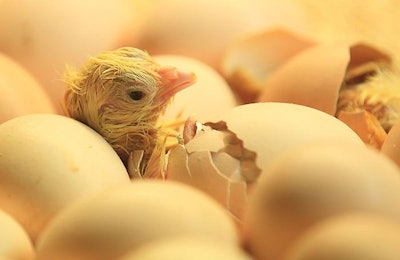
The Foundation for Food and Agriculture Research (FFAR) plans to offer as much as $6 million in prizes for the development of technologies that can accurately and quickly determine the gender of layer chick eggs before they hatch, also known as in-ovo sexing.
The FFAR reward program, known as the Egg-Tech Prize, was introduced October 17 at the United Egg Producers’ (UEP) Annual Board Meeting and Executive Conference.
Solution needed for male chick culling problem
Skilled workers in the egg industry are only able to identify the sex of the chick after it hatches, FFAR stated in a press release. For the 6 billion laying hens hatched each year worldwide, a similar number of male chicks are produced that never make it to market. The male chicks, once hatched, are unsuitable for consumption due to poor growth performance and meat quality. Because there is currently no need or the male chicks, they are culled, which creates major challenges for animal welfare, food waste, farm profitability and energy usage. This practice, known as male chick culling requires the industry to devote significant time and resources to incubating the male eggs only to cull them later.
“Male chick culling is a challenge that must be solved. However, promising scientific advancements indicate that it’s possible to develop a scalable technology to determine an egg’s sex before it hatches,” said Sally Rockey, FFAR’s executive director. “Solving this challenge would not only improve animal welfare, but also save egg producers billions while adding eggs to the food supply.”
UEP welcomes FFAR’s commitment
“UEP and our farmer-members commend FFAR for coordinating this valuable incentive to encourage researchers to move swiftly to identify meaningful, scalable solutions to this issue,” said Chad Gregory, UEP president and CEO. “Assuring the health and well-being of animals simply is the right thing to do. As such, we have an obligation to support practices and technologies that improve animal welfare across egg production, and this extends to finding an economically feasible, commercially viable alternative to the practice of male chick culling at hatcheries.”
Building on current approaches to solve problem
Current approaches to solving this challenge range from gene-editing to measuring an egg’s hormone levels to determine its sex. FFAR stated it is confident that the industry can build on recent advancements in sensor technologies, engineering and biological sciences to develop a technology that both successfully determines an egg’s sex before it hatches and can be integrated into existing production systems.
If new technologies allow egg producers to determine the chick’s sex early in incubation, over 6 billion male eggs could be directed into the food supply or vaccine production. Furthermore, if an appropriate technology is developed, the industry could save between $1.5 billion and $2.5 billion each year.
FFAR plans to begin accepting Egg-Tech Prize applications in early 2019. Initial grants will be followed by a final stage that culminates in proof of a working prototype that meets the criteria determined by an expert Steering Committee.

















